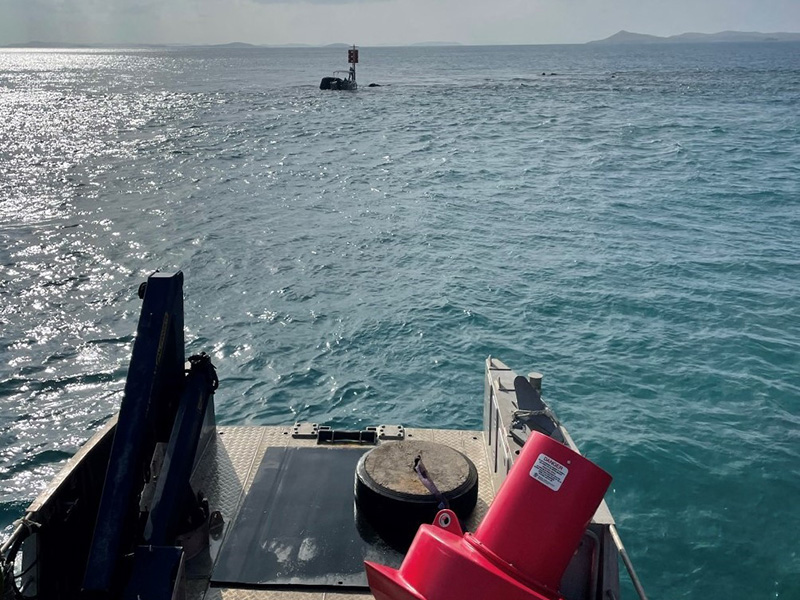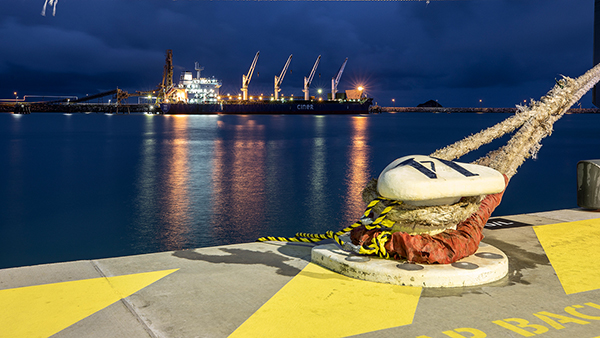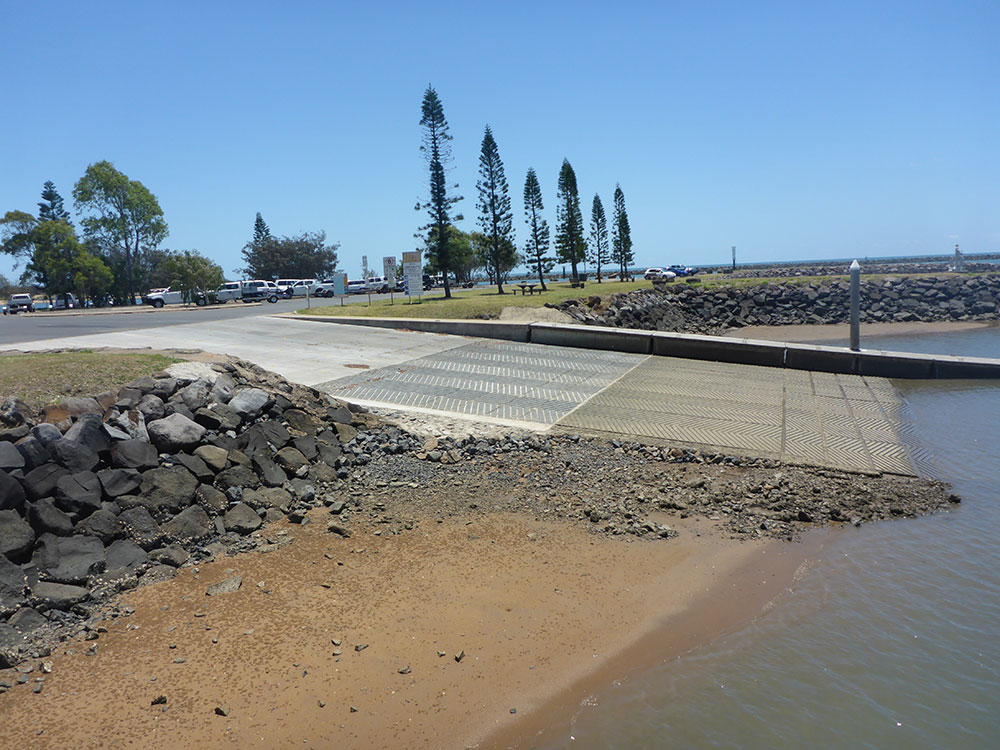Cyclones, storms and floods – be prepared and stay safe in extreme weather events
Maritime Safety Queensland has prepared an Extreme Weather Event Contingency Plan to help you plan now for what you will do if a warning is issued. The plan includes an overarching document containing critical information for all areas and separate appendices for each port or waterway area, containing relevant local information.
For more information, you can:
- stay informed using the Maritime Safety Queensland dashboard
- monitor the weather conditions via the Bureau of Meteorology website
- learn more about how to prepare for severe weather.
Maritime aids to navigation in the Torres Strait
Maritime Safety Queensland’s (MSQ’s) $3.9 million program to upgrade the maritime aids to navigation network in the Torres Strait is well underway.
In the Torres Strait, locals use the many aids to navigation in their waterways to make sure they travel, and return home, safely. The waterways are used for transport for work and education, travel between communities, and cultural activities.
Following consultation with waterway users and key stakeholders the first phase of implementation works was completed at the end of 2023, with the upgrades to marine buoys situated throughout the straits. The new marine buoys are larger and better designed to handle the sea conditions experienced in the Torres Strait.
In addition, MSQ has installed new marine aids to navigation in several locations, identified during consultation, to further aid safe navigation. This includes:
- new landfall light Kubin
- additional buoys to further delineate the Boigu and Saibai Island’s channels
- new buoys marking shoal offshore from Boigu and Saibai Island
- new buoys marking shoal hazards on the approach to Hammond, Thursday and Entrance Islands as well as at Brady Bank offshore from Seisia
- new buoy marking the entrance to the boat ramp at Injinoo.
Please refer to MSQ’s Notice to Mariners for specific details of each new installation.
MSQ is expecting to commence the second phase of the implementation works in March, with new steel beacons to be installed at several offshore locations, namely:
- southern approach to Badu
- entrance through the reef to St Pauls
- Buru (Turnagain) Island
- Numar Reef.
Steel beacons have been chosen due to the significant waves and currents encountered at these locations, as well as to optimise the visible range of the light at night.
In addition, a landfall light will be established at Mer Island and extra beacons installed to better delineate the channel at Warraber Island.
MSQ expects the second phase to be completed by June 2024.

Upcoming changes to lifejacket carriage requirements on registered boats
From Saturday 1 June 2024, the exception to the safety equipment requirements for carrying lifejackets on registered boats—other than personal watercraft or tenders, when operating in designated smooth waters—will no longer apply.
Currently, registered boats operating in designated smooth waters could be exempt from carrying lifejackets for everyone (1 year of age or older) on board under certain conditions. If the boat has level flotation, and grab lines, handles or a secure hold for each person onboard, lifejackets are not required to be carried on board in a river, creek or stream, or waters contained within breakwaters or revetments.
In our ongoing effort to enhance maritime safety, this exception will be removed from Saturday 1 June 2024.
Boaties are encouraged to prepare in advance of the changes by ensuring that their boat is equipped with the required number of lifejackets for everyone on board (1 year or older) when travelling in all waters.
Learn about safety equipment for recreational boats in Queensland.
Backing Queensland Maritime Jobs Initiative
The Queensland Government is implementing its Backing Queensland Maritime Jobs Grant Programs.
Read more about the initiative.

War on Wrecks
As at 29 February 2024, there are 1,349 fewer derelicts in Queensland waters because of Maritime Safety Queensland's War on Wrecks program. With around 517 additional vessels identified either as derelict or at risk of becoming derelict, we will continue to remove these rotting, unseaworthy and derelict vessels from our bays, rivers, and creeks.
Video transcript
Queensland is world-renowned for its beautiful waterways.
From the tip of Cape York to the Gold Coast, from the Great Barrier Reef through to our rivers and creeks, there's nowhere better to dive, fish or simply cruise.
In 2018, the Queensland Government committed $20 million over four years to the War on Wrecks program to remove derelict vessels and other hazards to help make these waterways pristine and safe.
A further $15 million for three years was committed in the 2022-23 budget, building on the success of the initial four-year program.
Maritime Safety Queensland, along with their partner agencies, are cleaning up Queensland.
And we need your help on the job by identifying existing vessels that have become waterway hazards as well as preventing the further abandonment of boats.
Because of the War on Wrecks, in the four years to June 2022, there's 1026 fewer derelict vessels in our waterways.
Ranging from sunken tinnies to barges—some barely recognisable—we've been making your waterways safer and cleaner.
In the 2021-22 financial year alone, the program has been responsible for the removal of 180 hazards from our bays, creeks and islands.
We have another 150 vessels on our to do list.
In May the program reached a major milestone with the removal of its 1,000th wreck – the Sonda from Cabbage Tree Creek.
Regions:
Every part of Queensland has benefitted from the program.
[Cairns] In Cairns, whether you enjoy snorkelling on the Great Barrier Reef or boating in tropical waters, there's now 134 less wrecks to detract from the region's beauty, and we're monitoring another 25.
[Townsville] If you're cruising around Magnetic Island or venturing out to the Hinchinbrook Channel, there are 86 fewer wrecks across the beaches and coastal areas around Townsville, making it safer, with another 5 being monitored.
[Mackay/Whitsunday] In Mackay and Whitsunday, known for its freshwater dams and hidden fishing spots, we are protecting the environment with 73 fewer derelicts, and we are managing 9 more wrecks.
[Gladstone] Think coral cays, rivers and tropical islands. Unfortunately abandoned vessels have caused issues for the beaches and ports in the Gladstone region. Since July 2018, the clean-up in this region means 123 fewer abandoned, and we have another 26 on our radar.
[Brisbane]Sunshine Coast, Brisbane, and the Gold Coast; we want these areas to be known as home to a treasure trove of sandy stretches, not navigation and pollution hazards. To date, the War on Wrecks program has been responsible for a decrease of 610 derelict vessels to improve the environment, and another 85 are being monitored by the team.
Now, we want you on board to help develop a whole-of-life approach towards responsible boat ownership, all the way through from manufacture to responsible disposal. We are looking at ways to ensure that everyone can safely enjoy Queensland's marine environment and invite you to work with us so we can all continue to enjoy safer, cleaner seas.
Watch for regional forums in 2023. To join the conversation, search War on Wrecks.
Find out more about the War on Wrecks.
New public marine facility laws

Maritime Safety Queensland has updated its public marine facility laws under the Transport Infrastructure (Public Marine Facilities) Regulation 2011. In late 2022, we asked for your feedback on proposed changes, many of which have now been implemented. The changes are aimed at improving the access, use of and safety at public marine facilities.
Maritime Minutes
Do you know which navigation lights you need for your powered vessel? Watch our video to find out.
View more:


